Would you love to get paid for sharing your ideas, stories, or expertise?
Imagine publishing a book without spending a dime on printing or chasing down a publisher.
Sounds great, right? With Amazon Kindle Direct Publishing (KDP), you can take control, publish your book, and make money from it while still enjoying the flexibility of working from home.
Today, we’ll discuss how to brainstorm profitable book ideas, validate them, write compelling content, and effectively market them.
So, grab a notebook and pen. Let’s uncover the secrets of self-publishing on Amazon Kindle and get you closer to your publishing dreams.
What Is Self-Publishing on Amazon Kindle?
In case you’re hearing this for the first time, Amazon KDP is a platform that offers authors an accessible, cost-effective way to bring their ideas to life and share them with a global audience.
Through Amazon Kindle Direct Publishing (KDP), you can upload your manuscript in digital format and publish it as an ebook or even a print-on-demand paperback and hardcovers.
Once your book is live on the platform, it becomes available for Amazon’s millions of active users to purchase.
This means your work can reach readers across the world without requiring a traditional publisher or distributor. What’s even better? The entire process is free. You won’t need to spend a dime to get started.
And guess what? You are keeping up to 70% of your royalties, which is far higher than what traditional publishing models typically offer.
The best of it is that the process is designed to be user-friendly, so even beginners can navigate it with ease. Isn’t it time to bring your book to life?
How to Come Up with a Book Idea
When self-publishing on Amazon, one of the most critical steps is choosing the right book idea. The one people want to read.
But where do you even start? As big as Amazon is, getting your book found should be your biggest concern, because, come on, there is a lot of competition on Amazon right now.
So, how do you come up with a book idea? Let’s start from somewhere…
1. Identify Your Passion
Passion is what keeps you writing, even when the process gets tough. Without it, your enthusiasm for the project can fizzle out, leaving you with an incomplete manuscript—or worse, a book that lacks the energy and authenticity readers crave.
That’s why your first step is to ask yourself: What excites me?
Think about the topics you naturally gravitate toward. What do you love discussing with friends? What activities light you up?
Knowing these things helps step you up one step. For example, if you enjoy imagining things that are far from your reach, you might be good at writing fiction books.
When you choose a topic you’re passionate about, your enthusiasm will shine through in your writing. Trust me, readers can sense when an author truly cares about a subject, and that energy is contagious.
So, take time to brainstorm. Write down everything you love, from hobbies to causes you believe in. Don’t hold back—this is the fun part!
Once you have a list, narrow it down by considering which topics you could write about in-depth.
2. Reflect on What You Know (or Want to Learn)
Do you have a list of things you’re passionate about? if you don’t have it yet, go write them, I will wait.
But the list isn’t enough. Your knowledge and experience are also valuable when it comes to writing a book.
Think about it: readers look to authors for guidance, information, or entertainment. If you’re already an expert in a particular field, you can leverage that expertise to create something truly impactful.
Go through your list and find areas where you are knowledgeable enough to write about.
Start by asking yourself a few questions:
- What do people often come to me for advice about?
- What skills or hobbies have I developed over the years?
- Have I overcome challenges or gained insights others might find helpful?
For example, if friends always ask for your budgeting tips or healthy meal ideas, those could be great book topics.
Or, if you’ve mastered a craft like photography or knitting, you could write a how-to guide to share your knowledge.
But what if you’re not an expert on anything (yet)? Don’t worry! Writing a book can also be an opportunity to learn something new. Choose a topic that fascinates you and commit to diving deep into research.
Readers will appreciate your fresh perspective, and you’ll gain a deeper understanding of a subject you’re curious about. It’s a win-win!
3. Solve a Problem
If you really want your book to resonate with readers, focus on solving a specific problem.
People turn to books for answers, and when your book addresses a real need, it becomes instantly valuable.
So, start identifying common problems within your niche. For example:
- Are busy parents struggling to find quick, healthy dinner ideas? Write a cookbook with simple, time-saving recipes.
- Are young professionals overwhelmed by personal finance? Create a beginner’s guide to budgeting and saving.
- Do aspiring writers feel stuck? Offer a roadmap to overcoming writer’s block and finishing their first draft.
The key is to put yourself in your readers’ shoes. What are they struggling with, and how can your book help?
A great way to uncover these pain points is by exploring forums, social media groups, or even Amazon reviews of similar books. Look for recurring themes or questions, and use them as inspiration for your book idea.
Once you’ve pinpointed a problem, position your book as the solution. Think about the value you’re offering. What will readers walk away with after finishing your book? Clarity? Confidence? A new skill? The more specific you are, the more appealing your book will be.
Solving a problem doesn’t just make your book valuable, it also makes marketing easier. When readers see your book as a solution, they’re more likely to click “Buy Now.”
Validating Your Book Idea
By now I believe you have a list of ideas right in front of you. But before you start writing, it’s essential to determine if your book idea has an audience.
Validating your book idea ensures there’s demand for the topic, and saves you from investing hours of work into a project that doesn’t sell.
Let’s validate your book ideas…
1. Find Your Category
Every book on Amazon is published under a category. It is important to find the best category for your book because this is where potential readers will look for content that matches their interests.
To begin, head over to the Amazon Kindle store. Navigate to Departments > Kindle E-Readers & Books > Kindle Books and scroll through the available categories.
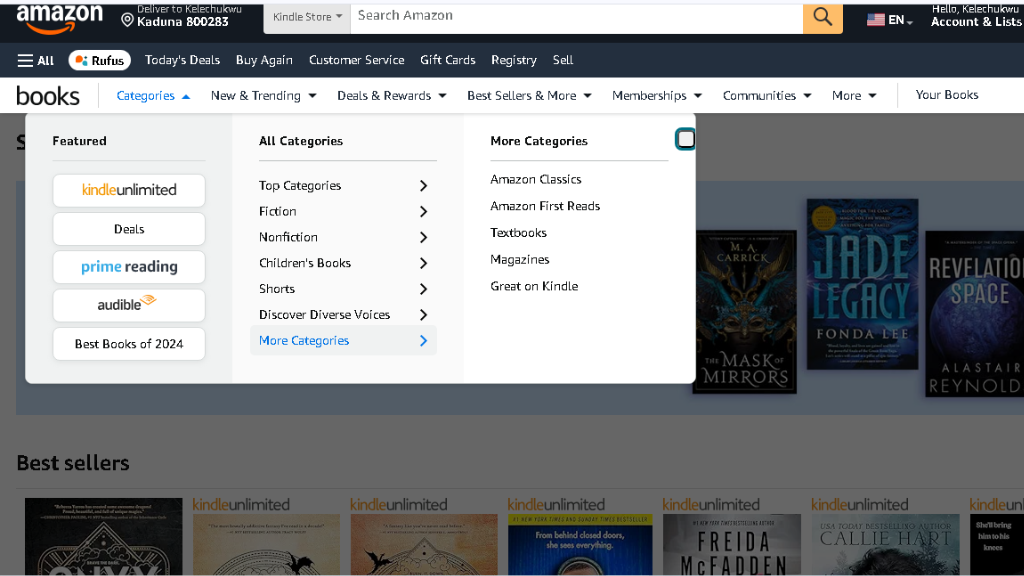
You might need to consider all subcategories, as these are often less competitive than broader categories.
Once you’ve identified a category that aligns with your idea, take time to analyze it further.
Look for niches with a healthy balance of demand and competition.
Categories that are oversaturated with books can make it difficult for new titles to stand out, while categories with too few books may indicate limited reader interest. Ideally, you want a “sweet spot” where the category has active buyers but isn’t overcrowded.
2. Check the Top 20 Books
Once you’ve narrowed down your category, take a closer look at the top 20 books within it. Why the top 20? These are the books that are performing well and capturing the majority of readers’ attention.
Studying them will give you invaluable insights into what works in your chosen niche.
Start by examining the book titles. Are they concise, descriptive, and engaging? Titles often give a clear indication of the themes and tone that resonate with readers.
For example, in the self-help niche, you might notice titles that promise specific outcomes, such as “Atomic Habits” or “The Subtle Art of Not Giving a F*ck.” Take note of patterns in the way these titles are structured.
Next, review the book covers. Do they feature bold, clean designs? Are they visually appealing and relevant to the topic? Book covers play a significant role in grabbing attention, so understanding what’s working in your niche can help you create a competitive design.
Descriptions are another crucial element. Read through the descriptions of the top 20 books and pay attention to how they’re structured.
Do they immediately address the reader’s needs or problems? Do they include compelling calls to action? The most successful descriptions are often written in a conversational tone, focusing on the benefits the book offers rather than simply summarizing its content.
Finally, examine the BSR of these books.
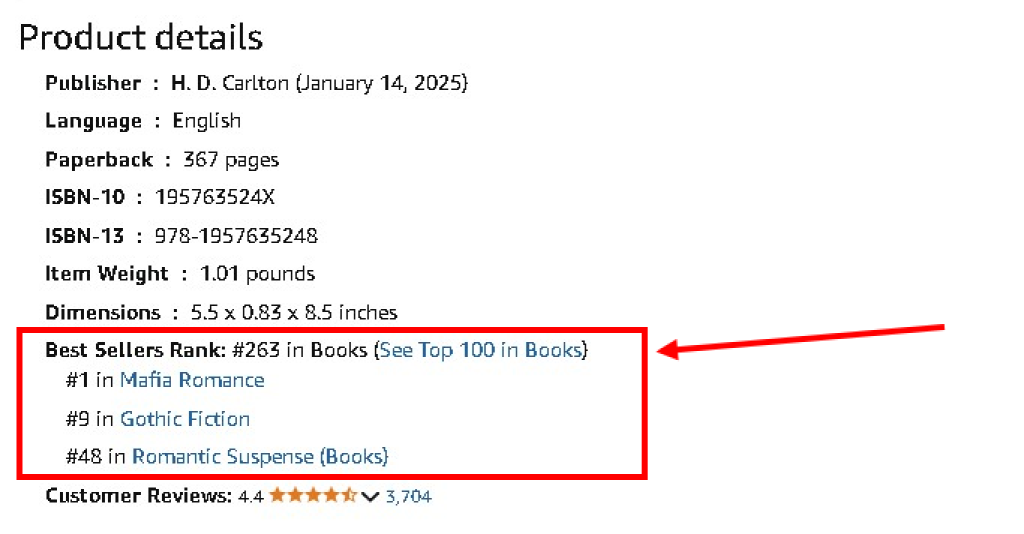
A book ranked #1 in its category is selling extremely well, while books ranked between 1,000 and 30,000 indicate moderate to strong demand.
Use this information to gauge whether there’s room for your book in this space. If all the top books are ranked very high (e.g., below 1,000), you may face tough competition.
However, if there’s a mix of high and moderate rankings, this suggests a more accessible niche for new authors.
3. Assess the Competition
Competition isn’t necessarily a bad thing. In fact, it can indicate that there’s a strong demand for books in your chosen niche. But, you’ll need to ensure your book offers something unique or does a better job addressing readers’ needs than existing titles.
Start by analyzing your competitors’ strengths and weaknesses.
What do their reviews say?
Browse through both positive and negative feedback to identify what readers love about these books—and what they wish was different. For example, if readers frequently complain about a lack of practical tips or poor editing, you can position your book as the solution by offering more actionable advice or ensuring it’s well-polished.
Take note of the pricing strategies your competitors are using. Are most books in your niche priced low to attract readers, or are they premium-priced to reflect their value?
Pricing your book appropriately is critical, especially if you’re entering a competitive niche.
Also, look at the unique selling points (USPs) of the top-performing books.
What sets them apart? Do they include bonus resources like worksheets, additional chapters, or access to online courses? If so, consider how you can add extra value to your book to make it stand out.
This can help you identify gaps in the market. These gaps represent opportunities for your book to fill a need that hasn’t been fully addressed.
For example, if most books in your niche are targeted at beginners, you could write a more advanced guide. Alternatively, if the existing books are long and detailed, you could create a shorter, more accessible version.
Preparing to Publish Your Book
Before hitting the “Publish” button on Amazon Kindle, you need to make sure your book has a fighting chance to capture readers’ attention.
In short, If the book itself is of the best quality, and the title, cover, and description are mediocre, the chances that it will sell are very slim.
Why? Because these elements work together to create a powerful first impression.
1. Craft an Eye-Catching Title
Once your book is published, your title is often the first thing readers notice, and it plays a significant role in whether they decide to click on your book.
A good title is more than just a name—it’s a promise. It tells readers what they can expect from your book and why it’s worth their time and money.
To craft a standout title, start by making it specific and clear. Generic titles like “Be Better” or “Success Secrets” don’t tell readers much. Instead, focus on creating a title that immediately conveys value.
For example, instead of “Improve Your Life,” consider a more descriptive option like “30 Days to a More Focused Mindset.” This gives readers a concrete idea of what they’ll gain.
It’s also important to include keywords that your target audience is searching for. This is because Amazon uses an algorithm called A9 to rank products based on relevance and quality to the user’s query.
For example, if you’re writing about personal finance, incorporating terms like “budgeting” or “financial freedom” can help your book show up in search results.
2. Design an Attractive Cover
The old adage “Don’t judge a book by its cover” simply doesn’t apply in self-publishing.
Readers browsing Amazon are inundated with choices, and your cover is the visual hook that draws them in. A poorly designed cover can cause even the most well-written book to be overlooked.
Start by researching the top-selling books in your category. Notice the common design elements: Are they bold and minimalist? Do they use specific colors, fonts, or imagery?
While you want your cover to stand out, aligning it with genre trends ensures it feels familiar and trustworthy to readers.
Also, choose fonts that are legible and match the tone of your book. For instance, a whimsical font might work for a children’s book, but a clean, bold font is better suited for a business or self-help book.
Avoid overcrowding the cover with too many words or decorative elements that distract from the title.
If design isn’t your strong suit, don’t hesitate to hire a professional. Platforms like Fiverr and 99designs offer affordable options for creating high-quality book covers.
3. Write a Captivating Description
If your title and cover have done their job, potential readers will move on to your book’s description. This is your opportunity to seal the deal and convince them to hit “Buy Now.”
Think of your description as your sales pitch—it needs to be engaging, informative, and persuasive.
The first line of your description should grab readers’ attention and compel them to keep reading.
For example, if your book is about productivity, you could open with a question like, “What if you could accomplish more in a day than most people do in a week?” Hooks like this immediately piques curiosity and makes readers want to learn more.
Next, highlight the value your book offers. Focus on what readers will gain rather than just summarizing the content.
For instance, instead of saying, “This book covers budgeting techniques,” say, “Learn how to save $500 a month with simple, proven budgeting strategies.” This shifts the focus to the reader and what they’ll achieve.
Structure your description in short, punchy paragraphs or bullet points to make it easy to skim.
And finally, encourage readers to take the next step, Phrases like “Click ‘Buy Now’ to start your journey today” can give them the nudge they need to make a purchase.
How to Publish Your Ebook on Amazon Kindle
Amazon Kindle Direct Publishing (KDP) is a straightforward process, even if you’re a first-time author. Let’s take a walk…
Step 1: Create a KDP Account
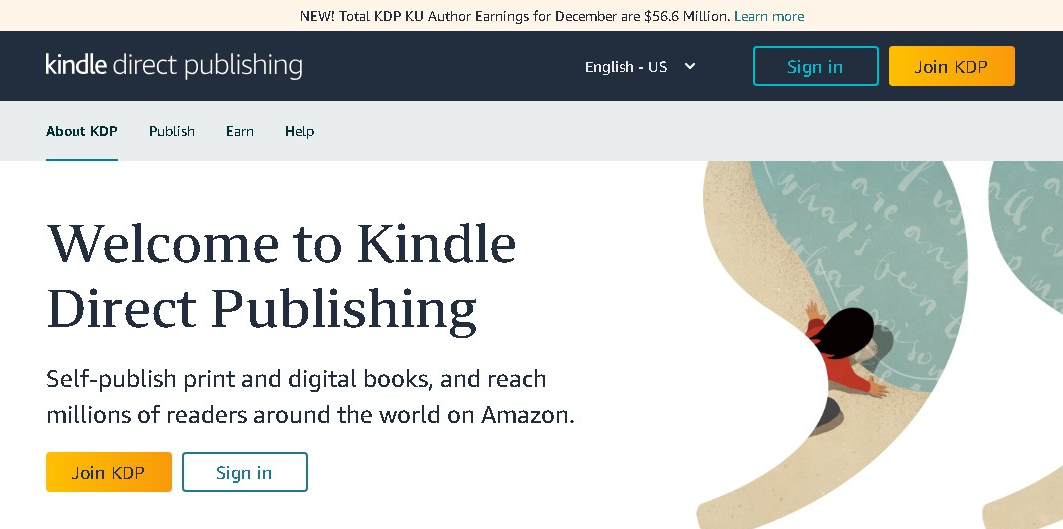
The first step is to sign up for a free Amazon KDP account. The process is very easy and only requires a few details. Sign up for a free account here →
Once your account is created, fill out the tax information under the “Your Account” section, and add your banking information to ensure Amazon can deposit your earnings directly.
Double-check that your details are accurate and up to date, especially if you’re located outside the U.S., to avoid payment delays. Once you’ve completed this, you’ll have a fully set-up account that’s ready to start publishing your first book.
Step 2: Add Your Book Details
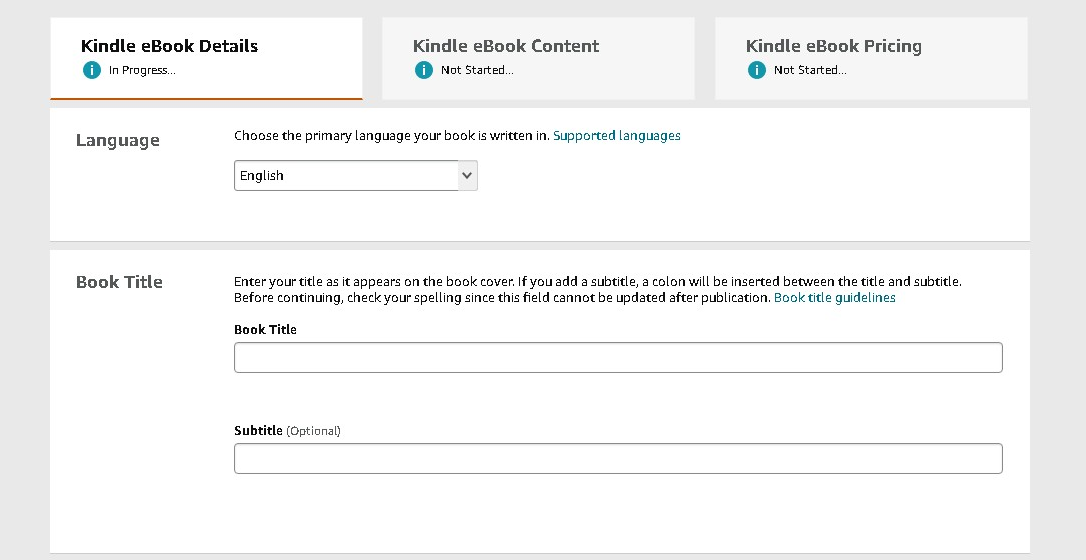
To be able to start publishing books, click the “Bookshelf” section of your KDP dashboard, then “Create a New Title” and start entering your book details.
In this section, you’ll have to provide a book title and subtitle, the author’s name or pen name, and a book description.
You’re also required in this stage to include keywords that people might use to search for your book. And you can add up to 7 of those keywords.
After that, you are required to select up to two categories that best match your book’s content. This determines where your book will be published.
Step 3: Upload Your Manuscript
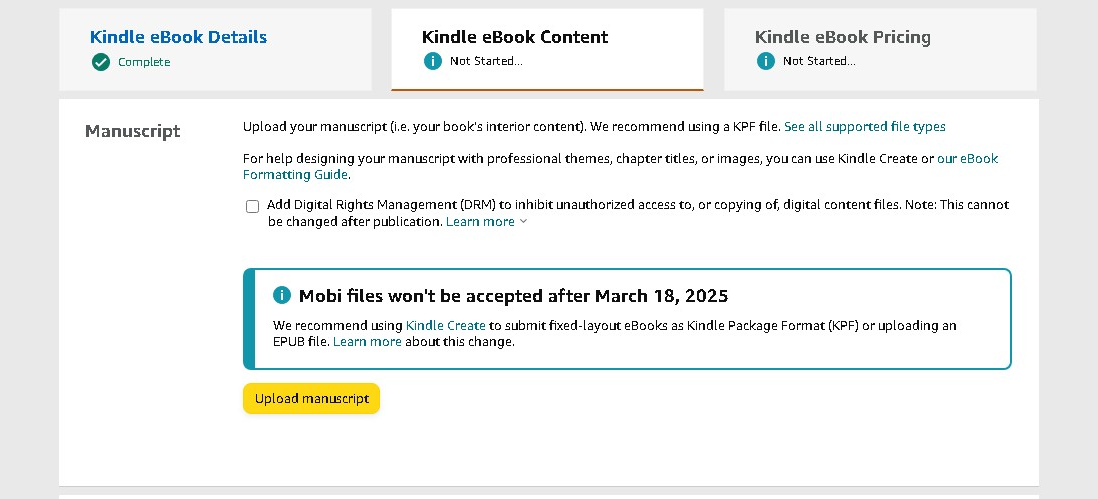
Next is uploading your manuscript. You can format your book in a Word document and upload it as a PDF or Docx. But for the best results, use Kindle Create to format your book for clean readability on all Kindle devices.
After you’ve uploaded your manuscript, add an attractive cover. You can design one yourself, hire a professional, or use Amazon’s free Cover Creator tool.
Use the Kindle Previewer to check how your manuscript and cover appear on various Kindle devices, and correct any formatting issues before moving forward.
Step 4: Set Pricing and Royalties
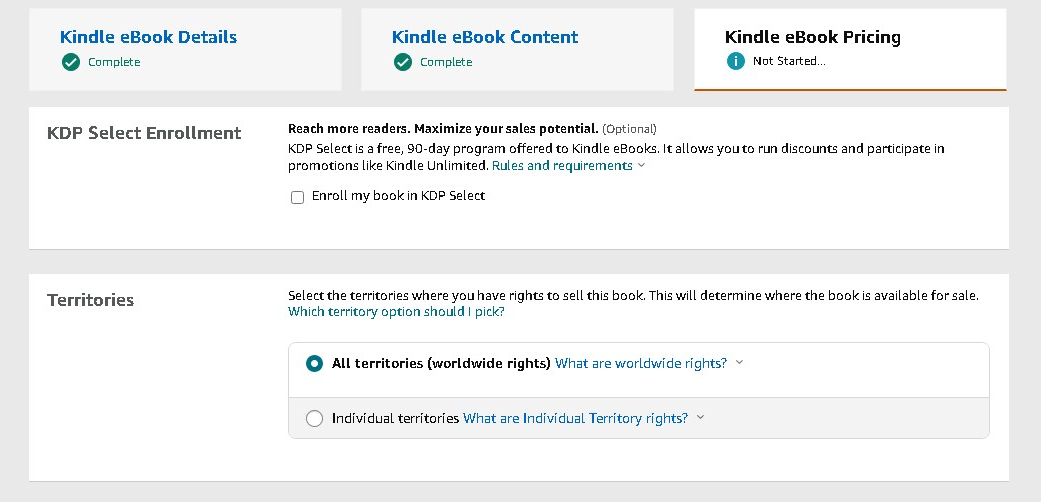
The last step before hitting the publish button is selecting a royalty rate. And you have two options: 35% or 70%.
The 70% option requires a price between $2.99 and $9.99 and offers better earnings.
Consider launching at $0.99 to attract readers and build reviews, and choose “Worldwide Rights” to make your book available globally to expand its potential reach.
After finalizing the price, confirm your settings and click “Publish Your Kindle eBook.” Amazon will review your submission within 24-72 hours.
Once approved, your book goes live on the Kindle store, ready to be purchased by millions of potential readers.
Promoting Your Book
Publishing your book is a significant milestone, but the real challenge comes in marketing it.
Even if your book offers the best value, without a solid promotion strategy, no one is going to find your book. You need to create awareness to drive sales and build a loyal reader base.
But what promotion strategies work? Let’s discuss it!
1. Start with a Launch Strategy
A good book launch strategy is your opportunity to create excitement, generate early sales, and accumulate reviews. The plan should be to approach your launch with a clear, intentional plan.
For me, a smart move would be to price my book at $0.99 during the first few weeks of its release.
This strategy lowers the barrier to entry for readers who are willing to take a chance on a new author. And trust me, this is how you generate a higher volume of sales and reviews, which can boost your book’s rankings in its category.
Also, don’t hesitate to announce your book on social media, share updates in writing communities, and email your network to encourage access.
After your initial launch period, you can gradually increase the price to $2.99 or $3.99 to align with the pricing of similar books in your genre. By this point, your book should have accumulated reviews and rankings.
2. Leverage Your Network
Friends, family, colleagues, and online followers can all play a role in spreading the word about your book. Find a way to engage them authentically and make them feel like part of your journey.
The best way most people do this is by announcing their book launch to their email subscribers if they have one. don’t worry if you don’t have a list, you can also rent one.
If you feel email isn’t enough, and you have a lot of followers on social media handles, feel free to create posts that highlight key aspects of your book.
Also, encourage your friends and followers to share your book with their networks.
3. Use Book Promotion Platforms
While promoting your book within your network, try expanding your reach beyond your immediate circle.
There are book promotion platforms that connect authors with readers who are actively searching for their next great read. If you want to find them, take a look at these options:
- Robin Reads
- Fussy Librarian
- Buck Books, and
- Books Butterfly
These services typically have large subscriber bases and can send targeted email campaigns featuring your book to readers interested in your genre.
While these platforms aren’t free, they can provide significant exposure and drive a spike in sales, especially during your book’s launch period.
When using promotion platforms, schedule your promotions to align with key milestones in your launch strategy.
FAQs
Can I make money with self-publishing on Amazon Kindle?
Absolutely! Many authors earn a steady income through KDP. However, success depends on the quality of your book, your niche, and your marketing strategy.
How much does it cost to publish on Amazon Kindle?
Publishing on KDP is completely free. You only incur costs if you choose to outsource services like editing or cover design.
Do I need to be a professional writer to publish on KDP?
No! Anyone with a good idea and determination can publish. Just ensure your book is well-written and properly edited.
Can I publish paperback or hardcover books on KDP?
Yes, KDP offers print-on-demand services for both paperback and hardcover books.
How do I get reviews for my book?
Encourage friends, family, and early readers to leave honest reviews. You can also use promotions to attract more buyers (and reviews).
What is KDP Select, and should I enroll?
KDP Select is a program that gives you exclusive promotional tools in exchange for Amazon exclusivity. Whether to enroll depends on your goals.
Final Thoughts
Self-publishing on Amazon Kindle removes traditional barriers, giving you the freedom to share your voice with the world while earning income on your own terms.
With the strategies outlined in this guide, you now have the tools to write, publish, and promote a book that stands out. Remember, every great author started somewhere—this could be your moment to step into the spotlight.
Don’t keep your story waiting. Begin your self-publishing journey today and take that first step toward making your book a reality.
If you found this guide helpful, share it with others who might be dreaming of publishing their book. Have questions or tips to share? Leave a comment below—I’d love to hear your thoughts and cheer you on!






